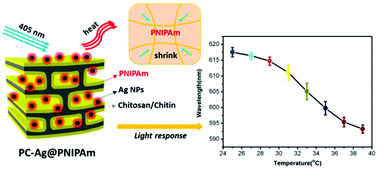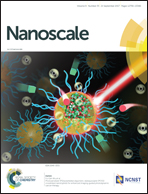A bioinspired poly(N-isopropylacrylamide)/silver nanocomposite as a photonic crystal with both optical and thermal responses†
Abstract
Responsive photonic crystals (PCs) would exhibit reversible changes in reflectance wavelength under external stimuli. Generally, external stimuli are applied, which would result in the variation of the photonic band gap. Internal stimuli would be more attractive for not destroying the hierarchical structures. Herein, we report a straightforward way to fabricate an optically induced thermo-responsive PC for the first time by coating butterfly wing scales with thermo-sensitive poly(N-isopropylacrylamide) (PNIPAm) with Ag nanoparticles formed in situ. As optic-thermo converters, Ag nanoparticles can convert light into thermal energy because of their surface plasmon resonance properties. The increase in temperature resulted in the phase transition of the PNIPAm coating on the wing scales, leading to the change of the bioinspired PC structure. Correspondingly, a blue shift in reflectance wavelength was detected for the obtained PC. Interestingly, a reversible optical thermo-responsive performance was observed through controlling the light source. This strategy is believed to be applied in other internal stimuli-responsive PCs with attractive properties, with the combination of various noble particles and a wide range of hierarchical photonic structures in nature.



 Please wait while we load your content...
Please wait while we load your content...